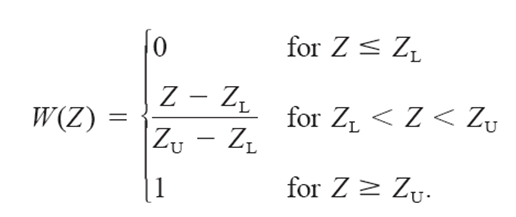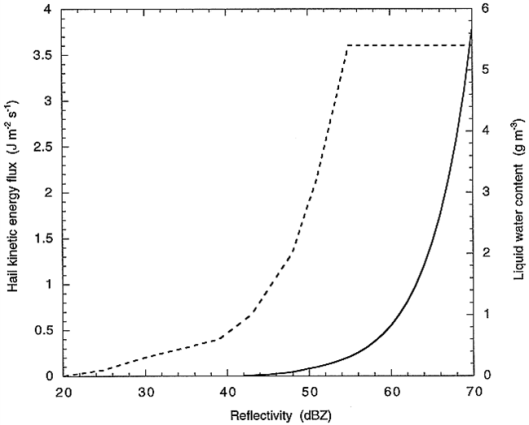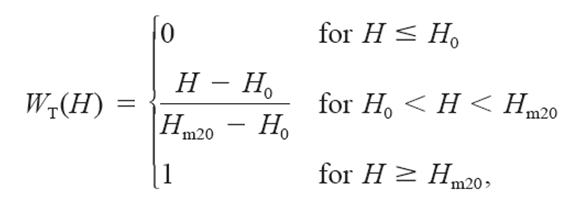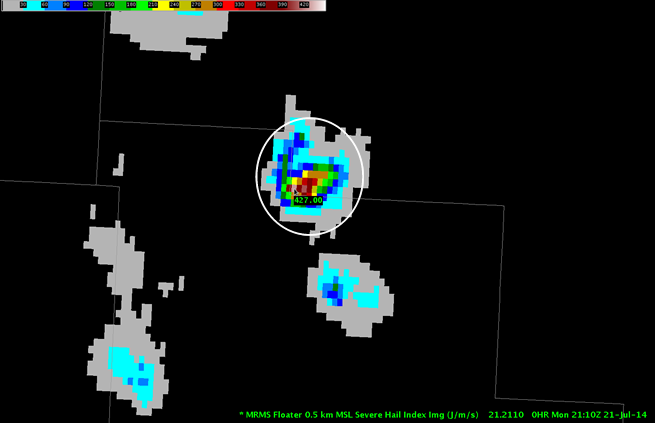Severe Hail Index (SHI) - Warning Decision Training Division (WDTD)
Navigation Links
Products Guide
Severe Hail Index (SHI)
Short Description
The Severe Hail Index (SHI) is used to compute the Probability of Severe Hail (POSH) and Maximum Estimated Size of Hail (MESH).
Subproducts
None.
Primary Users
None.
Input Sources
3D Reflectivity Cube
Vertical temperature profile from the current operational NCEP/EMC mesoscale model (i.e., the RAP as of 2014).
Resolution
Spatial Resolution: 0.01o Latitude (~1.11 km) x 0.01o Longitude (~1.01 km at 25oN and 0.73 km at 49oN)
Temporal Resolution: 2 minutes
Product Creation
This version of SHI is computed using the same cell-based equations as in Witt et al. (1998), except that it is vertically integrated on a multiple-radar 3D grid. Thermodynamic data (0° and -20° C) are integrated from numerical model analysis fields.
Technical Details
Latest Update: MRMS Version 10
To determine the presence of severe hail, an approach similar to the Vertically Integrated Liquid (VIL) algorithm was adopted. The first change involves using a reflectivity-to-hail relation, instead of a reflectivity-to-liquid-water relation as VIL does. The reflectivity data are transformed into flux values of hail kinetic energy (Ė) by:
 ,
,
where,

Here, Z is in dBZ, Ė is in J m-2 s-1, and the weighting function W(Z) can be used to define a transition zone between rain and hail reflectivities. The default values for this algorithm are ZL = 40 dBZ and ZU= 50 dBZ. While the VIL algorithm filters out the high reflectivities associated with hail by having an upper-reflectivity limit of 55 dBZ, the Z–Ė relation functions in the opposite way, using only the higher reflectivities typically associated with hail and filtering out most of the lower reflectivities typically associated with liquid water (Fig. 1).

Fig. 1: Plot of hail kinetic energy flux (solid curve), and liquid water content (used
to calculate VIL; dashed curve), as a function of reflectivity (Witt et al. 1998).
The second change involves using a temperature-weighted vertical integration. Since hail growth only occurs at temperatures < 0°C, and most growth for severe hail occurs at temperatures near -20°C or colder, the following temperature-based weighting function is used:
 ,
,
where, H is the height above radar level (ARL), Ho is the height ARL of the environmental melting level (i.e., 0°C), and Hm20 is the height ARL of the -20°C environmental temperature. Both Ho and Hm20 are determined from temperature profiles in numerical model analysis fields.
All of the above leads to the following radar-derived parameter, which is called the Severe Hail Index (SHI). It is defined as:

where, HT is the height of the top of the storm cell and Ė is calculated using the reflectivity profile of the grid point within the 3D Reflectivity Cube. The units of SHI are J m-1 s-1.
References
Witt, A., M. D. Eilts, G. J. Stumpf, J. T. Johnson, E. D. Mitchell, and K. W. Thomas, 1998: An enhanced hail detection algorithm for the WSR-88D. Wea. Forecasting, 13, 286-303.




